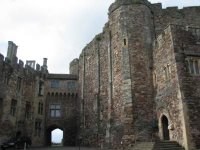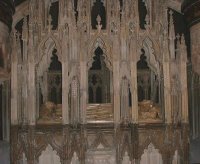

I had a great time in Gloucestershire, visiting sites associated with Edward II. The thing I most wanted to see was Edward II's tomb, in Gloucester Cathedral - a magnificent canopied shrine described by the Cathedral as 'one of the great monuments of England'. The shrine is currently covered in scaffolding, as it's being restored, at a cost of £70,000, apparently. The Cathedral is planning a 'series of events to commemorate Edward II' in 2007 and 2008.
I found it really moving to be so close to Edward - I stood there for ages, until one of the men working on the tomb started giving me funny looks. The day before, we'd visited Berkeley Castle, where Edward was imprisoned in 1327 (and freed by some of his supporters - see the comments on this post). I'm afraid to say I found Berkeley rather disappointing, at least from an Edward point of view. Much of the castle is closed to visitors, and the guided tour barely mentions Edward and focuses instead on the later Berkeleys. You can see the cell where Edward was held, but not enter it - you can only peer through a rather narrow window. I was hoping to get some idea of how the Dunheveds might have entered the castle in 1327 and freed Edward, but unfortunately I couldn't picture it at all. Still, Berkeley is well worth a visit (it's closed till next April, however) for anyone interested in later periods of history. I did enjoy seeing the Great Hall, which was rebuilt by Thomas Berkeley, Edward's jailor, around 1340.
In the photo (left, above) Edward's cell is above the doorway on the right.
We also visited Tewkesbury Abbey, a superb building consecrated in 1121, bigger than fourteen English cathedrals, which was saved during the Dissolution when the townspeople bought it for £453. The Abbey is practically the mausoleum of the Despenser family - the notorious Hugh the Younger was buried here in late 1330, in five pieces, after Edward III finally gave permission for his rotting remains to be removed from London Bridge, York, Carlisle, Bristol and Dover four years after his execution. His wife Eleanor de Clare is here (burial place unfortunately unknown) as are numerous descendants of theirs.
Another site associated with the Despensers is Hanley Castle, in Worcestershire. Sadly there's absolutely nothing left of the castle itself - except the flat hill where it once existed - but Hanley Castle, the village, is very pretty with a lovely old church and a school founded in 1326. Edward II and Queen Isabella were guests of Hugh Despenser here in January 1324, and Eleanor de Clare was abducted from Hanley by her second husband, William la Zouche, in early 1329.
We also took the opportunity to visit other historical sites in Gloucestershire and Worcestershire. Evesham is the site of a battle of 1265, where Edward II's father defeated Simon de Montfort, earl of Leicester - his uncle by marriage. Roger Mortimer - grandfather of Edward II's Roger Mortimer - sent de Montfort's head to his wife as a present! Worcester Cathedral contains the tomb of Edward II's great-grandfather King John (died 1216) as well as the chantry of Prince Arthur, elder brother of Henry VIII. The village of Deerhurst, a mile or so from where we were staying, contains two pre-Conquest buildings, astonishingly enough: Odda's Chapel, of 1056, and the Church of St Mary, which dates back to before 804. We didn't go in, but saw Sudeley Castle, former home of Henry VIII's last wife Katherine Parr, and spent a morning in the driving rain looking around Hailes Abbey - founded in 1246 by Henry III's brother Richard of Cornwall. Hailes was a very important place of pilgrimage in the Middle Ages.
All in all, I had a great holiday in a lovely, really interesting part of England!
19 comments:
Glad to have you back!
Aren't there some windows about Edward II at Gloucester Cathedral?
Thanks!
There's a window in the south wall that illustrates his murder, but I can't find a photo of it online (and I forgot to take one - too busy mooning around his tomb! ;) The East or Crecy Window (to commemorate the battle) is supposedly the biggest stained glass window in Europe.
Welcome back! It sounds a lovely holiday.
How exactly does the stained glass window illustrate Edward's murder? I mean, ahem, how - er - graphic is it about the - er - method?
Has Berkeley Castle changed a lot since 1327? Most castles seem to get remodelled and rebuilt by succeeding generations - the only thing new about the makeover show is TV - so it's possible it might have looked very different to the Dunheveds. Since one of them was a priest, do you suppose he could have got in under false pretences, maybe to conduct a service or take a confession or something?
I've always wondered what on earth there was between Roger Mortimer's wife and Roger Mortimer and Simon de Montfort to make Mortimer send her de Montfort's head as a present. Not a normal battlefield trophy! Suggests to me that there was Something Significant going on there. I don't think Sharon Penman did anything with it in Falls the Shadow, which slightly disappointed me (though I suppose one can only put so much in a book, even one of 500 pages).
Actually, I think the window (disappointingly) only depicts Edward III weeping over his father's body. No red-hot poker or pillow, unfortunately. ;) It's also much later, I think. Shame - and shame on me too for being so interested in Ed's tomb to the exclusion of everything else!
Berkeley has changed a lot - as can be seen in the photos on this page. The Great Hall, kitchen and buttery all look pretty medieval, though - if you ignore the much more recent windows in the Hall!
Paul Doherty's interesting theory is that the Dunheveds got into the castle by pretending to be members of the group of craftsmen carrying out repairs to the castle at the time - and your theory sounds plausible too. (I'll write something on all this ASAP. ;)
It's fascinating about Mortimer and de Montfort's head, isn't it? I'd love to know how Maud Mortimer reacted when she was presented with it. The whole situation is a great 'plotbunny' (as Gabriele calls it!)
Isn't it just? Who was Maud Mortimer's family? I ought to know, but I don't.
Doherty's idea sounds entirely plausible. Nigel Tranter does something similar, by having somebody rescue an imprisoned under-age Scots king by pretending they are delivering firewood to the castle and smuggling the boy out in the bottom of a cart - it's not a bad episode at all, though it's sadly about the best three pages in a novel that is, ahem, less than stellar.
The window sounds sentimental enough to be Victorian.
Maud was the daughter of Eva Marshal (one of the five daughters of William Marshal and Isabel de Clare) and William de Braose, who was hanged by Llywelyn the Great in 1230 for suspected adultery with Joanna (but you've read Falls the Shadow, you know the story. ;) She lived till 1301 and had about 7 children by Roger Mortimer.
Must get round to reading Tranter sometime, though I've read decidedly mixed reviews.
Actually, it's not Falls the Shadow, is it - it's Here Be Dragons.
I bought Here Be Dragons a while ago, but haven't read it yet. I'm really looking forward to it though - I love Penman's books, especially 'When Christ and His Saints Slept'.
Here Be Dragons is great, though I think I prefer Falls the Shadow - maybe because it's closer to my time period and I 'know' a lot of the characters. I wish Penman would write a novel on Edward and Isabella!
I just wish she'd finish her series on Henry and Eleanor instead of messing with the mysteries! I understand from lists that she's working on it, though.
I've never heard an explanation as to why Montfort's head was given to Mortimer's wife either. Maybe Mortimer had forgotten to make a trip to the jewelers and just grabbed whatever was handy: "Well, she can't say she has one of these already . . ."
Roger Mortimer: "Hi, honey, I'm home! And you'll never guess what I've brought you!"
Maud Mortimer: "??!!"
"Oh, how lovely! You shouldn't have!"
Lol, you two had me in stitches about that head.
Looks like a great trip, Alianore. More pics to come?
Susan,
I agree about Sharon finishing her Henry and Eleanor trilogy already. I'm not that much into mysteries.
BTW, which of Tranter's books, beside the Bruce trilogy, are worth reading? I've hear some are not so good than others, to put it mildly. ;)
Alianroe and Gabriele - rather than wander further off-topic here, I've posted my impressions of some of Nigel Tranter's novels elsewhere
The school in Hanley Castle was founded in about 1485 by a bequest from the de Hanley family (not 1326 - that date is when Elizabeth de Clare ordered two books to be purchased for her private chapel at the castle)
Philip (Hanley Castle)
Sorry about the picture - It's my wife's mother's grandmother.
how long has edward II's tomb been under restoration? I'm currently writing a paper about the history/architectural features of the tomb and could use any information you could offer. Any book/article/journal suggestions?
Thanks!
Hi Whitney - sounds like a fascinating paper! Unfortunately, I'm not sure if I can help you too much. My impression in early October was that the renovation was in its early stages, but I didn't see any info about when it started, or is expected to be completed. As the cathedral is planning some Edward II-related events in 2007/08, I would have thought the restoration would be finished by then, but....;)
I found this, which might be useful, and this, but there isn't too much info there either. I had a quick look at the Gloucester Cathedral website, but didn't see anything - but maybe you could email them? The official Cathedral guide only says '...effigy made of alabaster...this rests on a tomb chest clad in Purbeck marble. Its canopy is made of fine local oolitic limestone.'
The date of the tomb/effigy could make an interesting discussion. Given the current theory that Edward II wasn't murdered in 1327 but died much later, this would push back the date of the tomb's construction, of course. Ian Mortimer, Paul Doherty and Alison Weir have all written about this.
Offhand, I can't think of any articles specifically about the tomb - most of the books on Edward II mention it, though.
If I think of anything else, I'll post it here. ;) Let me know how the paper goes!
Oops, that first link doesn't work - it was meant to be this: http://www.glos.ac.uk/bgas/tbgas/v070/bg070144.pdf
Post a Comment